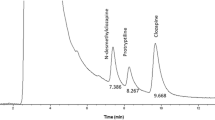Abstract
Background
Lithium salts (Li+) are still one of the most appropriate treatments in manic-depressive disorders. Since Li+ has a narrow therapeutic index, plasma levels must be closely monitored to verify maintenance pharmacotherapy, to prevent side effects, to evaluate compliance and to avoid increasing rates of relapse. Although it has been reported that Li+ concentrations in red blood cells (RBC) should be a better indicator of brain levels, therapeutic drug monitoring (TDM) of Li+ is not based on its routine assessment.
Objective
The aim of this retrospective study was to compare Li+ concentrations in RBC and plasma and the calculated ratio (LiR= RBC/plasma concentrations) in the three groups of patients.
Methods
During the past 3 years, 309 Li+ measures were collected corresponding to 165 patients classified into three subgroups (TDM, acute or acute-on-chronic intoxication). Li+ plasma (Cplasma) and RBC (CRBC) concentrations were determined by atomic absorption spectrophotometry.
Results
Results showed that Li+ concentrations in plasma are significantly correlated to Li+ concentration in RBC (r=0.81, P<0.0001). Although a wide inter- and intra-variability was found, Cplasma, CRBC and LiR were statistically different in the three groups. Compared with TDM, Cplasma was more elevated in cases of acute intoxication whereas Li+ accumulated preferentially in RBC in cases of acute-on-chronic intoxication.
Conclusion
This study shows the interest of determining Li+ in RBC and plasma for TDM, and that LiR could be a sensitive marker of intoxication and of Li+ impregnation.


Similar content being viewed by others
References
Finley PR, Warner MD, Peabody CA (1995) Clinical relevance of drug interactions with lithium. Clin Pharmacokinet 29:172–191
Burgess S, Geddes J, Hawton K, Townsend E, Jamison K, Goodwin G (2001) Lithium for maintenance treatment of mood disorders. Cochrane Database Syst Rev:CD003013
McIntyre RS, Mancini DA, Parikh S, Kennedy SH (2001) Lithium revisited. Can J Psychiatry 46:322–327
Linder MW, Keck PE, Jr. (1998) Standards of laboratory practice: antidepressant drug monitoring. National Academy of Clinical Biochemistry. Clin Chem 44:1073–1084
Amdisen A (1980) Serum concentration and clinical supervision in monitoring of lithium treatment. Ther Drug Monit 2:73–83
Rouillon F, Gorwood P (1998) The use of lithium to augment antidepressant medication. J Clin Psychiatry 59[Suppl 5]:32–41
Frazer A, Mendels J, Secunda SK, Cochrane CM, Bianchi CP (1973) The prediction of brain lithium concentrations from plasma or erythrocyte measures. J Psychiatr Res 10:1–7
Frazer A, Mendels J, Brunswick D, London J, Pring M, Ramsey TA, Rybakowski J (1978) Erythrocyte concentrations of the lithium ion: clinical correlates and mechanisms of action. Am J Psychiatry 135:1065–1069
Elizur A, Yeret A, Segal Z, Graff E (1982) Lithium and electrolytes plasma/RBC ratio and paradoxical lithium neurotoxicity. Prog Neuropsychopharmacol Biol Psychiatry 6:235–241
Flemenbaum A, Weddige R, Miller J, Jr. (1978) Lithium erythrocyte/plasma ratio as a predictor of response. Am J Psychiatry 135:336–338
Dehpour AR, Emamian ES, Ahmadi-Abhari SA, Azizabadi-Farahani M (1998) The lithium ratio and the incidence of side effects. Prog Neuropsychopharmacol Biol Psychiatry 22:959–970
Cold JA, ZumBrunnen TL, Simpson MA, Augustin BG, Awad E, Jann MW (1998) Increased lithium serum and red blood cell concentrations during ketorolac coadministration. J Clin Psychopharmacol 18:33–37
Taylor R, Mallinger AG, Frank E, Rucci P, Thase ME, Kupfer DJ (2001) Variability of erythrocyte and serum lithium levels correlates with therapist treatment adherence efforts and maintenance treatment outcome. Neuropsychopharmacology 24:192–197
Richelson E, Snyder K, Carlson J, Johnson M, Turner S, Lumry A, Boerwinkle E, Sing CF (1986) Lithium ion transport by erythrocytes of randomly selected blood donors and manic-depressive patients: lack of association with affective illness. Am J Psychiatry 143:457–462
Hisayasu GH, Cohen JL, Nelson RW (1977) Determination of plasma and erythrocyte lithium concentrations by atomic absorption spectrophotometry. Clin Chem 23:41–45
Dorus E, Pandey GN, Shaughnessy R, Davis JM (1980) Lithium transport across the RBC membrane. A study of genetic factors. Arch Gen Psychiatry 37:80–81
Ostrow DG, Pandey GN, Davis JM, Hurt SW, Tosteson DC (1978) A heritable disorder of lithium transport in erythrocytes of a subpopulation of manic-depressive patients. Am J Psychiatry 135:1070–1078
Sogut O, Yalcinkaya C, Saygili R, Tuglular I, Kayali A (1995) An attempt to predict daily erythrocyte lithium fluctuations. Eur J Drug Metab Pharmacokinet 20:271–274
Cazzullo CL, Smeraldi E, Scchetti E, Bottinelli S (1975) Letter: Intracellular lithium concentration and clinical response. Br J Psychiatry 126:298–300
Ferron G, Debray M, Buneaux F, Baud FJ, Scherrmann JM (1995) Pharmacokinetics of lithium in plasma and red blood cells in acute and chronic intoxicated patients. Int J Clin Pharmacol Ther 33:351–355
Montagnon F, Said S, Lepine JP (2002) Lithium: poisonings and suicide prevention. Eur Psychiatry 17:92–95
Scoble JE, McLean A, Munn S, Varghese Z, Sweny P, Moorhead JF (1990) Lithium nephrotoxicity and red cell lithium. Nephrol Dial Transplant 5:904
Johnson G (1998) Lithium—early development, toxicity, and renal function. Neuropsychopharmacology 19:200–205
Menghini VV, Albright RC, Jr. (2000) Treatment of lithium intoxication with continuous venovenous hemodiafiltration. Am J Kidney Dis 36:E21
Acknowledgement
The Department of Epidemiology and Biostatistics was supported partly by a grant from the Fondation pour la Recherche Médicale.
Author information
Authors and Affiliations
Corresponding author
Rights and permissions
About this article
Cite this article
Camus, M., Henneré, G., Baron, G. et al. Comparison of lithium concentrations in red blood cells and plasma in samples collected for TDM, acute toxicity, or acute-on-chronic toxicity. Eur J Clin Pharmacol 59, 583–587 (2003). https://doi.org/10.1007/s00228-003-0670-7
Received:
Accepted:
Published:
Issue Date:
DOI: https://doi.org/10.1007/s00228-003-0670-7




